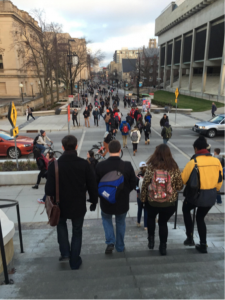Budget cuts have an impact beyond increased tuition
by Samantha Silverman
When budget cuts hit the University of Wisconsin System earlier this year, tuition increased for out of state students. The freeze on in-state tuition shifted a greater portion of the tuition burden to these non-resident students, some of whom already struggle to meet the cost of attendance.
Recently Governor Scott Walker cut $250 million from UW System funding. One way that UW-Madison Chancellor Rebecca Blank has aimed to make up for this cut is to increase out of state tuition by approximately $3,000 for the next two years and by $2,000 for the following two years. However, for many out of state students, this increase is significant. Students’ finances extend beyond their tuition fees. The cost of textbooks and living on campus creates an astronomical increase in the amount of money that students need to fund their education each year. This cost of attendance is significantly higher for out of state students due to the drastic gap between their tuition and that of Wisconsin or Minnesota residents; this gap has now widened.
Madison Laning, chair of the Associated Students of Madison, recognized that segregated fees only add to this cost. Segregated fees fund grants and different activities and organizations on campus. “Like anything, these are an additional cost to tuition of about $571 a semester. That is a lot of money to pay and we always make sure to keep that in our brains when we are making decisions about segregated fees,” Laning said.
Laning wants students to have an understanding of how the university
uses their tuition. For example, segregated fees, not tuition, fund the bowling alley in Union South. “We are working through ASM to make sure students have access to all this information and know where their tuition is going and where their segregated fees are going,” Laning said.
Laning also pointed out that one of the main reasons the university is getting by this budget cycle is due to the increase in out-of-state tuition.
According to the Academic Planning and Institutional Research Office of the Provost, resident total costs from 2014-2015 were $24,466 while non-resident total costs were $41,366. This difference has only grown during the 2015-2016 academic year.
While this cost of attendance is relatively low as compared to other public Big Ten institutions, the new increase in non-resident tuition will put UW-Madison on the same level as the average of other public Big Ten schools.
Steve Hahn, Vice Provost for Enrollment Management at UW-Madison indicated that the university is not “oblivious” to the fact that raising out of state tuition has real effects on students that are on financial aid.
“I understand the effects that (tuition increases) have, so for a certain segment of out of state students at the most need, we were able to secure some financial aid that made up the gap between old tuition and new tuition,” Hahn said. This UW-Madison Non-Resident Grant is awarded to needy non-resident undergraduates to make up the difference, and was implemented this year. Hahn is currently seeking to finalize arrangements with the campus to continue this in the future.
Yet, Laning is concerned beyond the tuition. “I am a firm believer that the Wisconsin Experience is rooted in money and how much money you have. For example part of the Wisconsin Experience is studying abroad or internships in other states many of which are unpaid or going to football games which is very expensive or going on trips with friends,” Laning said. She said students that already have a large student debt or are trying to secure financial aid to just go to class and pay for books aren’t able to truly take advantage of the Wisconsin Experience. This creates a large disconnect between the experiences the university has to offer and what some students have the means to pay for.
Hahn recognized that students on financial aid are missing out on these opportunities. “I think the only thing that I can suggest is that university administrators and the people that are responsible for reducing those costs, have every incentive and every desire to keep them as minimal as possible,” Hahn said. He also mentioned that searching for more need based aid is among the goals of the capital campaign the university launched in October.
Most recently, Hahn’s office surveyed students on the cost of attendance and living. They hope that this survey will give a better insight as to the costs students are facing.
Related Articles
UW-Madison student association accommodates students with food insecurities – by Kate Jungers
 The Arc: Visions of justice
The Arc: Visions of justice
